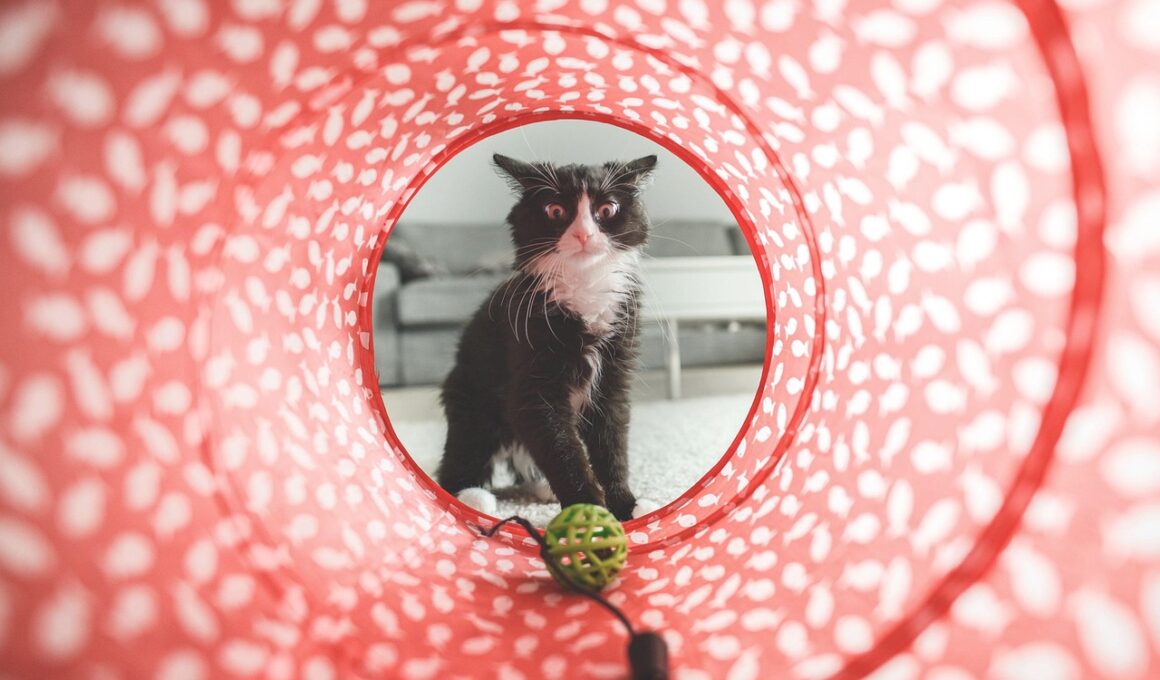Understanding Your Cat’s Toy Preferences for Social Play
When you bring home a new cat, understanding how they interact with toys can significantly enhance their socialization. Cats have various preferences when it comes to toys, and recognizing these can help encourage playful interaction. Some cats prefer plush toys that they can carry in their mouths, while others are more interested in toys that mimic prey, such as feather wands or laser pointers. By observing your cat’s behavior, you can identify what types of toys pique their interest. Additionally, the colors and textures can play a vital role in their appeal. For instance, bright colors may attract certain cats more than others that prefer natural tones. Offering a variety of toys can stimulate their curiosity and can help in reducing boredom. It is crucial to rotate toys periodically, as this can maintain their interest and excitement. Furthermore, engaging in playtime with your cat not only enhances their toy preferences but also strengthens the bond between you. Make time each day for interactive play, observing how your cat responds to different tools.
While engaging with your cat’s toy preferences, it’s equally essential to consider the types of materials used in those toys. Toys made from safe, non-toxic materials are not only better for your cat’s health but can also influence how much they enjoy playing. For example, many cats have a strong attraction to crinkly toys or those that include catnip. Catnip can stimulate playful behavior and brings out a more active side of your cat. Watching them enjoy catnip-infused toys can be highly entertaining. Additionally, interactive toys that allow for self-play when you are not home can also benefit a socially anxious cat. These toys can provide stimulation and reduce feelings of loneliness. Automated laser toys or ball launchers can keep your cat busy and prevent boredom. A well-stimulated cat is generally more content and likely to engage better socially, both with you and other pets. Always supervise your cat during playtime to ensure they don’t ingest any small pieces. Discovering the best toy options for your cat could require some experimentation, but the search will yield positive results.
The Importance of Variety in Playtime
Providing a variety of toys can significantly improve your cat’s social skills. Cats are naturally playful creatures, and having an assortment of toys allows them to express their instincts. For those unfamiliar, a lack of stimulation can result in behavioral issues or stress among cats. Therefore, investing in a range of toys—such as balls, feathers, and tunnels—will keep them engaged and mentally stimulated. Different toys can appeal to different cats, so it’s beneficial to experiment with various options. For example, some cats thrive with interactive toys that require them to think and solve puzzles, while others may be drawn to toys that enable stalking and pouncing behavior. It’s crucial to observe your cat’s play style by introducing new toys gradually and watching their reaction. Furthermore, the way you engage with your cat during play can also affect their development. Consider joining them in their game, fostering a sense of companionship and trust. Whether they prefer solitary play or enjoy teaming up with you to chase a dangling toy, each experience solidifies your bond together.
Safety should always be the top priority when selecting toys for your cat. Evaluate each toy for any small parts that could pose a choking hazard. Toys with long strings, such as wand toys, should be used only under supervision to avoid potential entanglement situations. Regularly check for wear, replacing toys that show signs of damage. Chewable toys should be specifically designed for safety to endure your cat’s natural instincts. Consider comfort too; some cats may prefer softer plush toys while others enjoy crinkly textures. Prioritize finding options that keep them engaged without compromising safety. Another fun aspect to consider is DIY toys. You can create fun, interactive toys from household items. For example, a paper bag or a cardboard box can provide endless entertainment when a little creativity is applied. Your cat’s interest can greatly vary based on how toys are presented; simple things sometimes result in the most joy. Ultimately, ensuring that playtime remains a safe, enjoyable experience will greatly enhance your cat’s socialization and overall happiness.
Understanding Your Cat’s Unique Personality
Each cat has its own personality, which means that toy preferences can vary greatly from one feline friend to another. Some cats may be more energetic and prefer toys that allow for high-speed chases, while others may enjoy a more laid-back approach, preferring to bat around a toy mouse rather than run after it. To cater to your cat’s uniqueness, it’s essential to observe your cat’s reactions during playtime. This can offer valuable insights on what kinds of toys ignite excitement and enthusiasm in your pet. Furthermore, consider the breed and age of your cat, as these factors also greatly influence toy choices. Kittens may be more inclined to engage with lightweight, colorful objects, while older cats might favor softer toys. Encourage exploration and play to gauge what excites your cat the most. Facilitate interactive play sessions, gradually incorporating new toys to see how your cat responds. By customizing play sessions to match your pet’s preferences, you foster a more satisfying play experience and nurture their social skills, enhancing the bond you share.
Incorporating toys into your cat’s socialization journey will promote healthier interactions with people and other pets. By regularly engaging in play, you not only stimulate physical activity, but also expose your cat to new experiences that can help reduce anxiety. Social playtime can take place with you or with other cats, allowing them to practice important skills such as grooming and pouncing. Introduce toys during group play sessions to encourage shared playtime and cooperation. Individual play can foster confidence, while group sessions can teach them valuable social cues. Encourage positive reinforcement through treats during these sessions to strengthen learning. These dual approaches will aid in developing a well-rounded personality in social contexts. Always remember that maintaining a calm environment during play and supervision is critical. This helps reinforce good behavior and minimize excessive aggression. As your cat learns to play and socialize, their personality will continue to blossom. Each toy can provide a unique opportunity for growth and social learning, so it’s important to leverage every play session as a chance to nurture those skills and increase their comfort with interactive play.
Final Thoughts on Cat Toy Evaluation
In conclusion, understanding your cat’s toy preferences is a fundamental aspect of enhancing their social interactions. The right toys can encourage exercise, mental stimulation, and bonding opportunities between you and your feline. Remember to pay attention to their likes and dislikes while continuing to introduce a variety of new toys. Be patient during this discovery phase, as it may take time to see what your cat truly enjoys. Observing their behaviors will guide you in making informed choices about toy types and materials they respond to. Consistent and safe playtime reinforces social bonds, reduces stress, and improves overall well-being. As your cat becomes more comfortable with toys and play scenarios, their social skills will enhance, translating into improved relationships with humans and other pets. Regular interaction and play provide an essential platform for cats to develop their personalities and learn valuable social cues. Let playtime be a joyful exploration for both you and your cat, ensuring that every session is fulfilling and enriching. By investing in your cat’s play experience, you contribute positively to their socialization and happiness.


